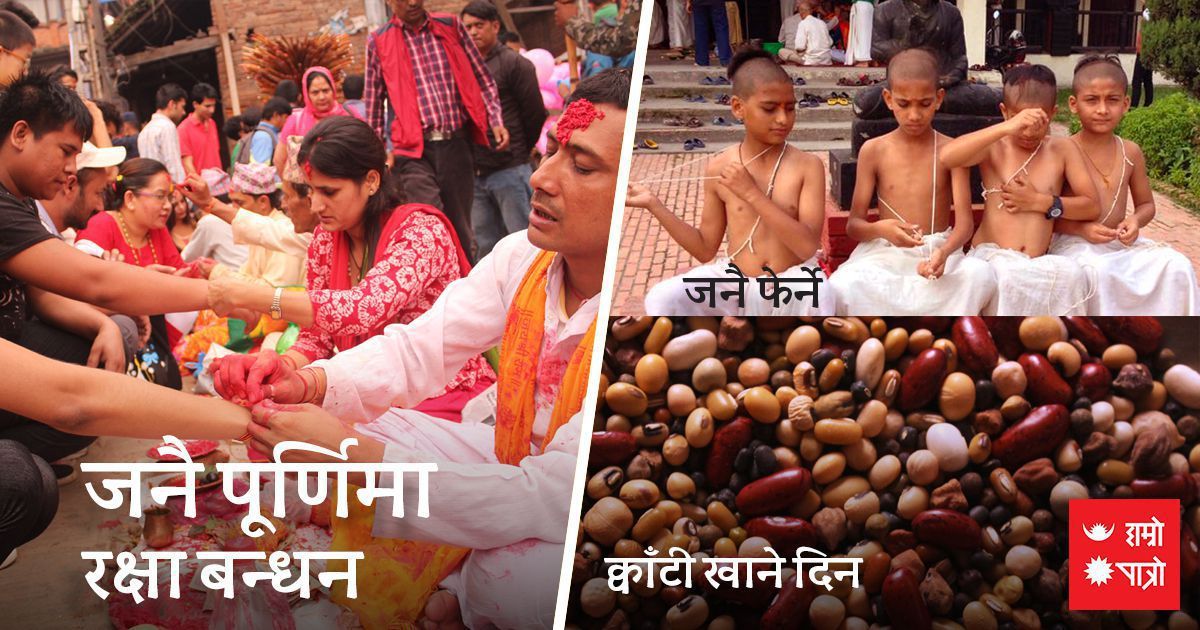
“येन बद्धो वलीराजा दानवेन्द्रो महावलस् । तेन त्वां प्रतिबध्नामि रक्षे मा चल मा चल ।।"
The plain and the lowlands terraces already have been cultivated. It is now, probably the time to plant pre sown paddy. Bhadaure paddies have starts rapturing and the enthusiastic festivals are coming adding cherished. Actually, festivals are the times of recreation after cultivation. Moreover, it adds color to life.
All the shops are filled with the colorful ‘Rakhi’ which have added more happiness in the festival. Those sisters having brothers in their home, have you brought Rakhi? And those brothers what kind of gifts do you have for your sisters?
Different festivals have their own importance or treatise, such as Janai Purnima is related to a sacred thread where thread means the bond of purity or security. Hindu Nepalese men of Brahmin and Chhetri group perform their annual ritual of changing Janai. After childhood, after practicing ritualistic rituals, chanting mantras in the ears that others do not listen to by the guru priest, they are prepared by the guru purohit, with a firm resolve to follow the path of truth and right-handed fall on the left shoulder. In this way, the mantra is made by placing two raw knots (2 cotton yarn) for each of the two different knots. It is customary to change the present-day annually, one of the sir ghagora doras of the two coins in Janai, the three strings on the coins, is considered as the sum of karma, worship, and knowledge.
Today’s chant:
“येन बद्धो वलीराजा दानवेन्द्रो महावलस् ।
तेन त्वां प्रतिबध्नामि रक्षे मा चल मा चल ।।"
Meaning:
I will tie you with the same threat that protects (the black colored thread) that was tied to Bali, the great king of the demon.
On the occasion, of the cow worship Day (Laxmi pooja) in about October, this thread is then taken out from the wrist and tied on the tail of the cow. It is believed that doing such rituals cow will help him/her to cross Baitari river, the way to heaven. some people also go to temple with the priest and tying the thread on the temple.
This festival is also marked by tying off a colorful Rakhi or holy thread, by the sister on the wrist of her brother blessing his success. The rituals and importance of these festivals are of great importance in the coastal areas of Nepal as well as in India, Bangladesh, and other countries.
Today, it is also customary for the son-in-law to go and raise his father-in-law. Today Pashupatinath of Kathmandu, kumbeshwar mahadev of bhaktapur, gosaikunda of rasuwa , Gangasagar of Janakpur, Dhanusanagar, Dolkunda of solukhumbu , halesi of khotang, Danasadhu of Jumla.
Especially: It is celebrated in the community of Brahmins, Chhetri or some other Buddhist worshipers by wearing string mantras in the hands of a Brahmin priest. According to the Hindu Vedic scriptures, there is a group of 7 cotton yarn that is made of raw yarn, used accepting merit for performing Brahma sutra, Vedantic work and for the study of Vedas. Brahma, Bishnu and Maheshwar, one of the coins, is considered as the sum of the symbols of karma, worship and knowledge.
In the context of change, the followers of Sanatan Dharma, who has been purified beyond the Brahmanas or Kshatriyas who have been subjugated or worshiped, cannot be applied to the sacrificial people, and they can wear them. Remember that wearing the sacred rituals is believed to receive direct energy from the Sun God, and the pronunciation of Gayatri Mantra is believed to increase physical, mental and spiritual potential.
Also, after holding the sacrificial offering, he also qualifies to be the creator and engineers of all the external deeds. Today, Vedic Sanatan Dharma is traditionally regarded as caste-based and untouchable, which is only a narrow blip.
Yagnapavit acts as a passenger to the Brahmanpath, however, Brahmanpath means that birth is not the path through karma. Brahmin is the path of spiritual purity, the god of the whole world and the pursuit of diligence. Brahmins do not need to be remembered merely as caste, language, and religion. Regardless of religion or caste background, one can become absorbed in the Brahmin path of modernity and spiritual purity.
Kwati:
One of the special dishes that are not to be missed at the festival is the ‘kwati’ made from soaked beans. Today’s day is also called ‘kwati’ eating day. Kwati is called when the sprout grows in a mixture prepared by mixing different types of beans soaked in water for two days. The beans, which grows green stalks, are typically cooked and cooked as a roasted vegetable, and this is an important taste of the day.
Kwati is its own way of baking, a delicious dish can be prepared by roasting, roasting it with a vegetarian taste or mixing mutton or poultry meat. Today, people eating kwati have been relieved to eliminate various diseases related to the digestive tract. The specific type of food consumed by the Newar community is called "Nwangi"
Whether you are in the country or abroad, with family or without family, whether you believe in or not in any religion, whatever you are doing today, this sacred thread of love or affection between brothers and sisters, affection and bond of love for all of us. For the continuation of the tradition of adulthood, continue to be the hallmark of endless love, harmony. Inheritance and all the defense case, seeks a full moon, happy Raksha Bandhan.
Liked by: